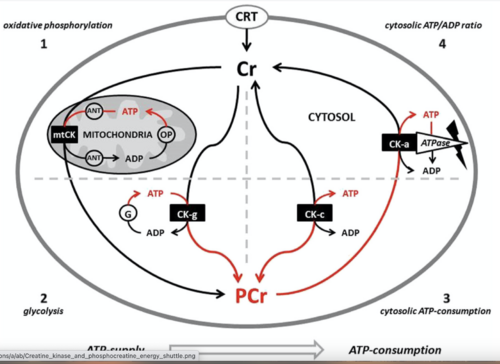Creatine Phosphokinase (CK or CPK)
Original Editor - Lucinda hampton
Top Contributors - Lucinda hampton, Kirenga Bamurange Liliane and Vidya Acharya
Introduction[edit | edit source]
Creatine phosphokinase (CPK) AKA creatine kinase (CK), is the enzyme that catalyzes the reaction of creatine and adenosine triphosphate (ATP) to phosphocreatine (PCr) and adenosine diphosphate (ADP). It is a reversible enzyme reaction that subsequently produces ATP from PCr and ADP. The PCr made is then used to supply tissues and cells that need substantial amounts of ATP, for instance the brain, skeletal muscles, and the heart, with this much needed ATP. Creatine phosphokinase (CK) is a major controller of homeostasis in cells. Numerous conditions cause disruption of CPK levels, including rhabdomyolysis, heart disease, kidney disease, and certain medications.[1]
CK in Blood Tests[edit | edit source]
The appearance of CK in blood tests is usually considered an indirect marker of muscle damage, especially for diagnosis of medical conditions such as myocardial infarction, muscular dystrophy, and cerebral diseases (eg injuries and infections to the brain, brain tumors and dementia).
- Naturally muscle cells will release CK as a part of day to day life. Certain people eg certain ethnic groups, fit men with larger muscles have naturally a higher normal CK level than other people (for example older women).
- Heavy exercise can cause higher CK levels, as well as muscle damage caused by eg a fall, an injection into a muscle, road trauma, surgery. Not all exercise creates the same CK response. A large increase in plasma creatine kinase occurs after eccentric loading, however only a small increase in CK levels in the blood after concentric loading occurs. In some medical conditions (eg myositis, muscular dystrophy) were elevated CK levels is a feature concentric exercise should be considered over eccentric exercise.[2] [3]
- The molecular mechanisms causing CK release from muscle after mild exercise remains unclear. Clarification would help give important information for those concerned about muscle hypertrophy, performance, and the significance of rest periods between periods of exercise.[4]
Specific Examples[edit | edit source]
- Creatine kinase activity is one of the oldest markers of acute myocardial infarction (AMI).[40] Creatine kinase activity begins to rise within 12 hours of AMI symptoms, peaks at 24 to 36 hours, and normalizes after 48 to 72 hours. The issue with measuring creatine kinase activity for AMI is that it is not specific to the heart. CK activity can increase in several conditions, such as rhabdomyolysis, chronic muscle diseases, burns, and even after strenuous exercise.
- Serum CK activity is greatly elevated in all types of muscular dystrophy.
- Serum CK activity characteristically falls as patients get older and as the mass of functioning muscles diminishes with the progression of the disease.
- CPK levels also elevate in patients with rhabdomyolysis[52]. Rhabdomyolysis may result from a crush injury, drug use, viral infections, and strenuous exercise. It typically presents with muscle pain and weakness alongside dark-colored urine.
- Some drugs, particularly cholesterol-lowering drugs (statins), can damage muscle and increase CK. Patients on statins such as simvastatin may have an adverse effect of significantly elevated CPK levels, potentially leading to rhabdomyolysis.
- Serum CK activity demonstrates an inverse relationship with thyroid activity. About 60% of hypothyroid subjects show an average elevation of CK activity fivefold more than the upper reference limit.
- Plasma creatine kinase activity is significantly associated with blood pressure in the general population and is thought to contribute to hypertension by increasing vascular contractility and renal sodium retention.[5]
Resources[edit | edit source]
References[edit | edit source]
- ↑ Aujla RS, Patel R. https://www.ncbi.nlm.nih.gov/books/NBK546624/ StatPearls. Treasure Island (FL).Available:https://www.ncbi.nlm.nih.gov/books/NBK546624/ (accessed 4.2.2024)
- ↑ Koller A, Müller E, Artner-Dworzak E, Haid C, Schobersberger W, Puschendorf B, Raas E. Metabolic Changes Following Concentric and Eccentric Exercise in Trained and Untrained Subjects. InAdvances in Ergometry 1991 (pp. 406-409). Springer Berlin Heidelberg. Available:.https://link.springer.com/chapter/10.1007/978-3-642-76442-4_57 (accessed 5.2.2024)
- ↑ Pathology tests explained. CK Available at:https://www.pathologytestsexplained.org.au/ptests-pro.php?q=Creatine%20kinase%20(CK) (accessed 5.2.2024)
- ↑ Baird MF, Graham SM, Baker JS, Bickerstaff GF. Creatine-kinase-and exercise-related muscle damage implications for muscle performance and recovery. Journal of nutrition and metabolism. 2012 Oct;2012.Available:https://www.ncbi.nlm.nih.gov/pmc/articles/PMC3263635/ (accessed 5.2.2024)
- ↑ Aujla RS, Patel R. Creatine Phosphokinase. StatPearls. Treasure Island (FL). Available:https://www.ncbi.nlm.nih.gov/books/NBK546624/ (accessed 6.2.2024)







